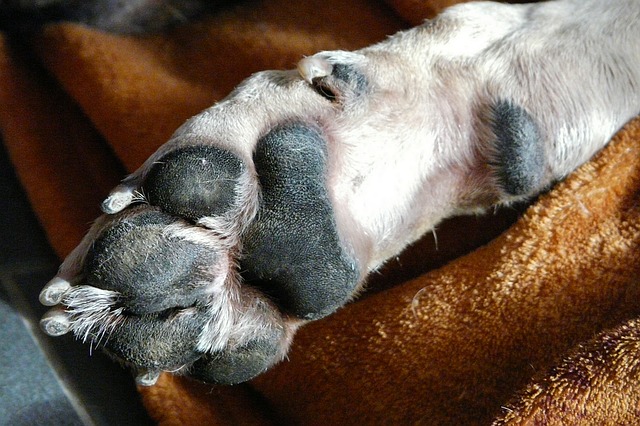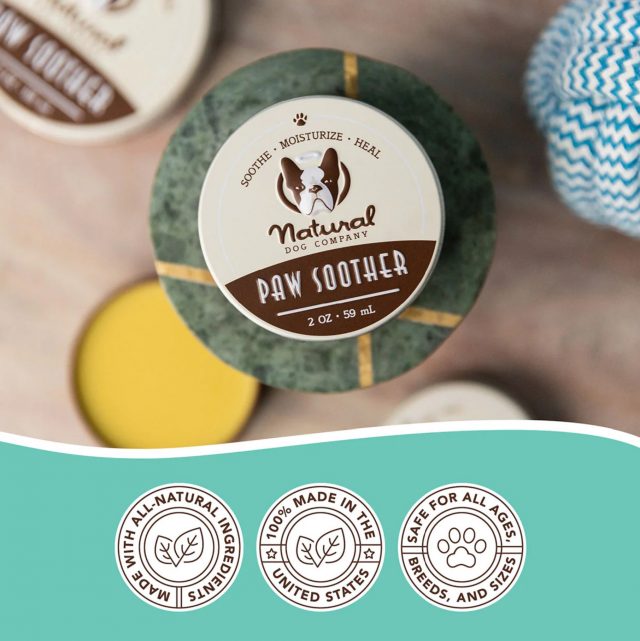Paw Pad Hyperkeratosis is often referred to as “hairy dog feet” because the paw pads take on a distinctly furry appearance.
In fact, what you are seeing is an overgrowth of a tough, fibrous protein called keratin that resembles fur, but is actually rough, hard and quite uncomfortable for your dog.

Keratin provides strength and resilience to the epithelial cells of skin, hair and nails, but sometimes the body makes too much, resulting in hyperkeratosis. When overproduced, this excess keratin forms a hard, crusty layer of fur-like protrusions on the nose and/or paw pads.
Hyperkeratosis has different levels of severity, but in its most aggressive form it can cause cracking, bleeding and infection of the paw pads.

Some breeds have a genetic predisposition for hyperkeratosis of the paws, including Golden Retrievers, Labs, Dogues de Bordeauxs, and some Terriers. Pups with genetic hyperkeritosis typically develop signs of “hairy dog feet” by their first birthday.
Non-genetic hyperkeratosis can be idiopathic – meaning the cause cannot be determined – or a symptom of disease. Dogs with idiopathic hyperkeratosis typically do not develop problems until they are seniors, while those experiencing “hairy dog feet” as a symptom of disease may be any age.
The following diseases are known to cause paw pad hyperkeratosis:
- Leishmaniasis is a skin disease spread by sand flies that is characterized by skin lesions and may also cause an overproduction of keratin.
- Dogs suffering from Zinc Responsive Dermatosis are incapable of properly absorbing zinc and may develop hyperkeratosis as a symptom.
- Pemphigus foliaceus causes pustules and crusting of the skin as well as thickening and cracking of the footpads.
- Canine distemper, a highly contagious and potentially life-threatening virus that attacks the respiratory, gastrointestinal and nervous systems also causes hyperkeratosis of the paw pads in some dogs.

If you observe changes to your dog’s normally soft, smooth paw pads, schedule an examination with your veterinarian to rule out disease and prevent the condition from progressing. Hyperkeratosis cannot be cured, but it can be managed.
If left unchecked, the hard, hairlike growths and cracking can cause your dog’s pads to become extremely sensitive, especially when walking on rough, hard, hot or cold surfaces. Some dogs experience such significant pain they become unwilling or unable to walk, reducing their quality of life.
Treatment and long-term maintenance are essential for keeping your pooch on his paws!

After examining your dog and ruling out the above diseases, your vet will likely trim away the excess keratin using medical scissors or a dremel tool. This procedure should only be attempted by a professional. Trimming is painless if done correctly, but an untrained hand could accidentally injure the delicate paw pad beneath the crust.
Keeping the overgrowth at bay will allow your dog to walk more comfortably, but regrowth is rapid and maintenance trims should be performed every few months. Some vets may recommend soaking or steaming the paws to help soften excess tissue and relieve discomfort between trims.

To heal and moisturize your dog’s damaged pads, apply a soothing balm rich in pet-safe essential oils and butters. Natural Dog Company Paw Soother is a unique blend of all-natural ingredients including Cajeput Essential Oil, Calendula Extract, Rosemary Extract, Jojoba Oil, Hempseed Oil, and Cocoa Butter – to name just a few!
Each nourishing ingredient is designed to deliver effective, safe healing. From the highly antiseptic power of the Cajeput Essential Oil to the bacteria-repelling moisturization of the Jojoba Oil, your pup’s paws will find effective relief. Plus, you can choose from a tin or a stick applicator for easy application.
Since all Natural Dog Company products are free from harmful ingredients, you do not have to worry about you pooch getting sick, and with daily applications, relief is fast and long-lasting!
Soothe your pup’s paws and get 15% off your order when you shop from Natural Dog Company. USE code HOMELIFE15.

With your care and attention, paw pad hyperkeratosis can be managed, giving your dog the chance to live his best life free from pain and discomfort!
These statements have not been evaluated by the Food and Drug Administration. This product is not intended to diagnose, treat, cure, or prevent any disease. The information on this website is not intended to replace a one-on-one relationship with a qualified healthcare professional.
H/T to Canine Journal & Natural Dog Company
 Toledo, United States.
Toledo, United States.
